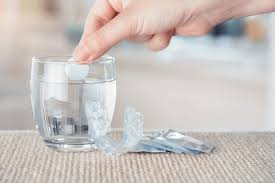In the ever-evolving landscape of oral care, the quest for efficient and convenient methods of cleaning oral appliances has led to the emergence of sterilizing tablets. These tablets, designed to eliminate bacteria and germs, are touted as a hassle-free solution for maintaining oral hygiene. This article explores the ins and outs of sterilizing tablets, delving into their effectiveness, safety, and whether they can truly replace traditional cleaning methods for oral appliances.
Understanding Sterilizing Tablets
Sterilizing tablets, often marketed for their versatility, claim to be a one-stop solution for disinfecting various oral appliances. From dentures and retainers to mouthguards and orthodontic appliances, these tablets are promoted as a time-saving alternative to conventional cleaning methods. The key ingredient in most sterilizing tablets is usually an antimicrobial agent, often activated by dissolving the tablet in water.
The Pros of Sterilizing Tablets
1. Convenience:
One of the primary advantages of sterilizing tablets is their convenience. Users simply dissolve a tablet in water, submerge their oral appliance, and let the sterilization process take its course. This simplicity can be particularly appealing for individuals with busy lifestyles who seek a quick and easy way to maintain the cleanliness of their oral devices.
2. Comprehensive Disinfection:
Sterilizing tablets are formulated to provide comprehensive disinfection, targeting a wide range of bacteria, fungi, and viruses that may accumulate on oral appliances. This broad-spectrum approach ensures a thorough clean, addressing not only surface contaminants but also those in hard-to-reach areas.
3. Reduction of Odors:
Bacteria and germs on oral appliances can contribute to unpleasant odors. Sterilizing tablets, by eliminating these microorganisms, can help reduce or eliminate the odors associated with prolonged use of oral devices. This can be particularly beneficial for individuals using appliances like retainers or mouthguards.
4. Time Efficiency:
Sterilizing tablets typically offer a quick disinfection process, requiring only a fraction of the time compared to some traditional cleaning methods. This time efficiency can be advantageous for those who prioritize a streamlined oral care routine without compromising on effectiveness.
The Cons of Sterilizing Tablets
1. Limited Mechanical Cleaning:
While sterilizing tablets excel at killing bacteria and germs, they may have limitations in terms of mechanical cleaning. Unlike manual brushing or using specialized cleaning tools, tablets may not effectively remove certain debris or buildup on oral appliances. Users should consider combining sterilizing tablets with other cleaning methods for a more comprehensive approach.
2. Material Compatibility:
The effectiveness of sterilizing tablets can vary based on the material of the oral appliance. Some materials may be more resistant to the tablet's active ingredients, potentially compromising the overall disinfection process. It's essential to check the compatibility of sterilizing tablets with specific oral devices to ensure optimal results.
3. Residue Concerns:
Some users have reported concerns about residue left on oral appliances after using sterilizing tablets. While manufacturers strive to formulate tablets that dissolve completely, there may be instances where a residue is left behind. This residue can be a cosmetic concern and may require additional rinsing or cleaning steps.
4. Cost Considerations:
Sterilizing tablets, though convenient, may come with a cost. When compared to traditional cleaning methods such as using mild soap or specialized cleaning solutions, the ongoing expense of purchasing sterilizing tablets may be a factor for budget-conscious consumers.
Tips for Effective Use of Sterilizing Tablets
For individuals considering the use of sterilizing tablets for their oral appliances, it's important to keep the following tips in mind:
1. Follow Manufacturer Instructions:
Adhering to the manufacturer's instructions is crucial for achieving optimal results. This includes the recommended duration for soaking the oral appliance, the water temperature, and any additional steps specified in the product guidelines.
2. Combine with Mechanical Cleaning:
To address both microbial contamination and physical debris, consider combining the use of sterilizing tablets with mechanical cleaning methods. Brushing or using specialized cleaning tools can enhance the overall cleanliness of oral appliances.
3. Check Material Compatibility:
Before using sterilizing tablets, verify that they are compatible with the material of your oral appliance. Certain materials may require alternative cleaning methods to ensure both safety and effectiveness.
4. Address Residue Concerns:
If residue is a concern, be diligent about rinsing the oral appliance thoroughly after using sterilizing tablets. This can help minimize any potential cosmetic or taste-related issues associated with residue.
Conclusion
Sterilizing tablets offer a convenient and efficient way to disinfect oral appliances, presenting an attractive option for individuals seeking a streamlined oral care routine. While they come with notable advantages, users should be mindful of their limitations, including potential issues with residue, material compatibility, and the need for supplementary mechanical cleaning.
Ultimately, the decision to rely solely on sterilizing tablets or to integrate them into a comprehensive cleaning regimen depends on individual preferences, lifestyle, and the specific oral appliance in question. Consulting with a dentist or orthodontist can provide valuable insights into the most effective and safe cleaning practices for maintaining optimal oral health. As the world of oral care continues to evolve, striking a balance between innovation and tried-and-true methods ensures a bright and healthy smile for years to come.

